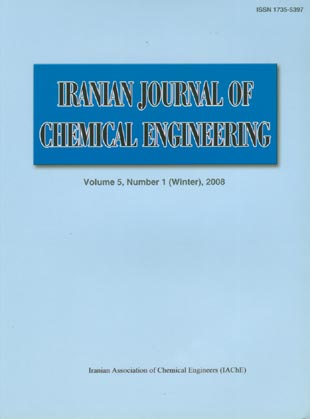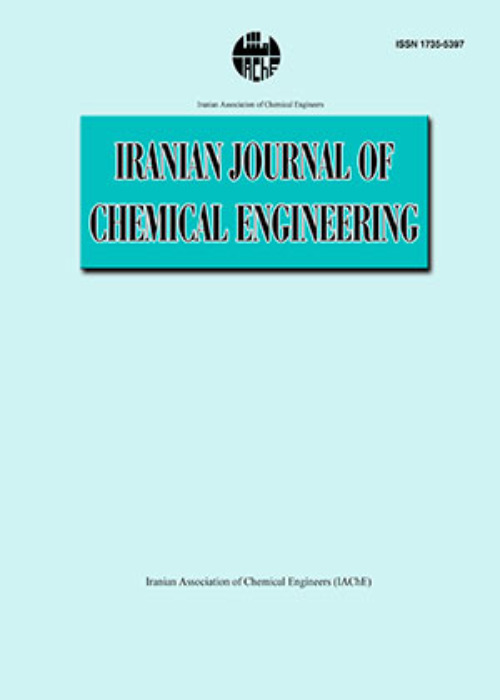فهرست مطالب

Iranian journal of chemical engineering
Volume:5 Issue: 1, Winter 2008
- تاریخ انتشار: 1386/10/11
- تعداد عناوین: 7
-
-
Page 3The influence of different factors on the asphaltene stability in three iranian crude oils was evaluated. Compositional studies and structural characterization of resins and asphaltenes were carried out in order to study a possible relationship between these properties and asphaltene deposition behavior. Low hydrogen to carbon ratios and high aromaticities were the main characteristics of the asphaltenes from more unstable crude oils. According to these results, the stability behavior of asphaltenes was influenced strongly by their structural characteristics. Colloidal stability indexes such as the (aromaticë ") / (asphaltene«± n^«) ratio and (aromaticsë ") / asphaltene ratio do not play a key role in the asphaltene stability for the studied crude oils.Keywords: Asphaltene, Crude oil, Stability, Structural Characterization, Flocculation
-
Page 13Common methods to design heat exchanger networks (HENs) by pinch technology usually need an evolutionary step to reduce the number of heat transfer units. This step is called loop breaking and is based on the removal of exchangers that impose minimum increase on utility consumption. Loops identification and breaking is a tedious task and becomes more complicated in large networks. This paper presents a rapid nonlinear programming (NLP) formulation for the evolution of HENs in which loop identification is not required. The objective of the NLP is the minimization of HENs annual cost, which is not considered in current methods. In this method a search is done to find the best units elimination of which improves HENs annual cost. The search continues until the minimum number of units (MNU) is achieved and the exchangers that must be removed from the network are specified. The method was applied to some networks reported in the literature and better results were obtained. Also, the convergence of the presented method is very fast and it can be applied to different networks designed by pinch technology.Keywords: Heat exchanger networks (HENs), Minimum number of units (MNU), Loop breaking, Nonlinear programming (NLP
-
Page 22Synthesis of heat exchanger networks (HENs) is inherently a mixed integer and nonlinear programming (MINLP) problem. Solving such problems leads to difficulties in the optimization of continuous and binary variables. This paper presents a new efficient and robust method in which structural parameters are optimized by genetic algorithm (G.A.) and continuous variables are handled due to a modified objective function for maximum energy recovery (MER). Node representation is used for addressing the exchangers and networks are considered as a sequence of genes. Each gene consists of nodes for generating different structures within a network. Results show that this method may find new or near optimal solutions with a less than 2% increase in Hen annual costs.Keywords: Heat exchanger networks (HENs), Optimization, Genetic Algorithm (G.A.), NLP formulation
-
Page 34In this research an extensive literature search into the mechanism of cavitation dynamics and its consequences was conducted. A cavitation venturie rig was designed and constructed, and the cavitation number was checked mathematically. A new camera technique was developed to capture the cavitation cloud. Carbon steel (AISI 1020), stainless steel (AISI 304 and 316), ferritic alloy steel (B1274), brass (C27000), phosphor bronze (C51000) and aluminum bronze (C60800) test pieces were prepared and tested in the venturie tube. Aluminum bronze was the most and carbon steel the least resistant of these alloys, the measured mechanical properties could not systematically be correlated with cavitation resistance. The microscopic examinations showed that cavitation induced plastic deformation had caused the misalignment of polishing lines. A field study into the susceptibility of an Iranian sugar cane company’s centrifugal pumps showed that deviation from the manuals hydraulic settings caused cavitation and that the gray cast iron had a poor resistance. Besides the venturie tube, other configurations were considered, of which an oil industry choke valve was constructed and examined for cavitation.Keywords: Cavitation, cavitation, erosion, cavitation cloud, cavitation resistance alloy, cavitation number, cavitation camera technique
-
Page 41In this paper a chemical method applied to synthesize exfoliated graphite (EG) is presented. In this method graphite intercalation compound (GIC) was firstly synthesized by chemical treatment of graphite flakes using a mixture of sulfuric and nitric acids followed by thermal shock of GIC at 1000°C to produce EG. The bulk density of synthesized EG was found to be as low as 4.5 kg/m3. X-ray diffraction (XRD) and scanning electron microscopy (SEM) techniques were used for identification and characterization of different materials. According to the XRD observations, the GIC was identified as graphite bisulfate with stage 2, and residue GIC and EG had nearly the same diffraction pattern, but with distinctly lower intensity. In accordance with SEM results the residue graphite bisulfate was swelled in comparison with the graphite flake. The oil sorption capacity of synthesized EG in this work was studied by common static and dynamic tests and compared with other sorbents. The results show the superior capability of EG for oil spill cleanup.Keywords: Exfoliated graphite, Oil Spill, Sorption, Crude Oil
-
Page 65In order to study the effective factors on the quality and quantity of lecithin extracted from soybean oil and the residual amount of phosphatids in degummed oil, this study was arranged. Crude oil recovered from soybean which had been processed by conventional solvent extraction and reached a phosphorus content of 454 ppm was used for this purpose. Treatments were carried out under different concentrations of phosphoric acid (zero, 0.05, 0.1, 0.2, 0.5, 2) and different percents of water ( 0.5, 1, 2, 5, 3, 4) at different temperatures (25, 50, 60, 75, 90 °C) and with different stirring times (5,10, 20, 40, 60 min). The highest phosphatid recovery was obtained with 3 %(v/v) water at 75 °C with a stirring time of 20 minutes. Adding phosphoric acid decreased the phosphatid residue in the degummed oil, but the quality of lecithin was reduced. However, the addition of phosphoric acid lower than 0.05 %(v /v) at 60 °C resulted in the same recovery efficiency with no major effect on the quality of lecithin.Keywords: Soybean oil, Degumming, Lecithin, Phosphatid, Extraction
-
Page 74


